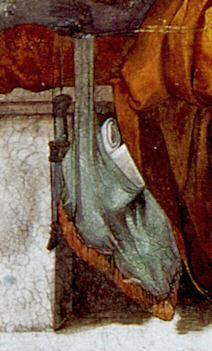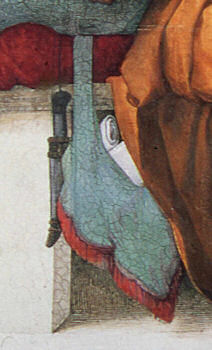
This is a perfect example of how art displays have been corrupted by the incessant demand to produce blockbusters. The emergence of the Renaissance is probably the most familiar story in the whole history of art. Every textbook account explains how artistic changes in the early fifteenth century can be seen first in sculpture. And every guidebook to Florence explains that it's a story that can be seen most clearly in the encyclopaedic sculpture collection at the Bargello. This exhibition, a ten minute walk from the Bargello, re-tells that story.
Parts of it are good. Each room has a different theme, and some are successful. The Disseminating Beauty room was particularly worthy of being a stand-alone exhibition. It focuses on the Donatello and della Robbia workshops, bringing together some wonderful masterpieces and shows their influence with works by their students and followers. I got a new appreciation of the della Robbias from this display, although I'd seen the individual works before. Donatello's great Pazzi Madonna can be seen better here than in Berlin, where it's displayed quite high. There were several other works that could be seen more clearly than in their usual homes, including the Michelozzo Angels from the Victoria & Albert Museum. Sculpture is hard to re-arrange because it often has to be fixed to the walls with big structural supports, but it did make me think that some of the great permanent collections of sculpture could do with being re-arranged from time to time.
Other parts are weak, and relate badly to the rest. The pottery knick-knacks in a room about rich patrons were out of place. The main part of the exhibition is about the very highest art, and putting some contemporary luxury goods alongside adds nothing. The latter part of the exhibition was running out of ideas, so they moved from from a focus on art to a focus on patronage. Nothing wrong with that - it's an interesting theme. But it stretched the exhibition too far. Room 9 is devoted to confraternities as patrons, but who can focus on such an arcane area after the earlier treats?
The exhibition was consistently patchy. It was great to see the ancient bronze horse head, the Medici Protome alongside Donatello's massive horse head, the Carafa Protome. But the explication of the relationship between developments in sculpture and developments in painting was half-hearted. Too often collections of sculpture and collections of paintings are kept apart (National Gallery and V&A, Bode Museum and Gemaldegalerie in Berlin, Uffizi and Bargello in Florence), so it would have been worthwhile to bring together painting and sculpture to show parallel development. That is done to a degree, but the focus is firmly on sculpture, and the paintings are not always well-chosen. It was a missed opportunity to show so many fabulous marble portrait busts without showing early painted portraits alongside.
Turning to the positive, the exhibition catalogue is superb. It sensibly avoids being another narrative overview of the Renaissance - general histories are already widely available. Instead, it has a large number of short essays including some by leading scholars, many of which are excellent. The kaleidoscopic approach gives an effective overview, and the catalogue section is informative and well-illustrated. It's good value for money, and worth getting even if you're not going to the exhibition.
Many of the works in the exhibition were cleaned specially for the occasion. This seems irresponsible, because it imposes a strict deadline on the work. If something is taking longer than expected to conserve, there must be immense pressure to hurry to job along to ensure it's ready for the exhibition. The timetable of restoration on precious and delicate works of art should be dictated by need, not by the pressure of blockbuster exhibition schedules.
Despite getting all of these fabulous loans, and cleaning many of them specially, the display itself was unworthy. Cheap plywood backing seemed to be imitating stone walls, but just looked tacky. I was the first person through the doors on the first day of the exhibition (I have a long backlog of things to write up!), but several displays were conspicuously dusty and the glass on the Masolino was absolutely filthy. The dirt was highlighted by bright spotlights that make it hard to appreciate sculptures in the round; as so often, a torch is essential. The small bronze Marcus Aurelius by Filarete is especially hard to see.
Exhibitions should be an opportunity to bring art together into a meaningful context. Shamefully this exhibition has separated parts of a single artwork. Donatello's St George and the Dragon is part of his sculpture of St George that is in the Bargello. The main part is still in the Bargello, with a plaster cast in place of the lower part, which is in the exhibition. Elsewhere pictures of works of art have been included in the exhibition where originals couldn't be borrowed (such as a fresco by Uccello). This is a tawdry practice that elides the difference between original and copy, and shifts the whole focus of the exhibition away from the art itself and towards the curatorial narrative, treating works of art as illustrations of a thesis.
If this sounds harsh, it's partly because this lazy excuse for an exhibition has had an excessively easy ride from critics who were understandably impressed by the artworks themselves. Parts were good, and could have been developed into excellent focused displays. Bringing all of it together dulled the impact. The demand for jazzy blockbusters rather than more focused and meaningful exhibitions impoverishes our appreciation. Meanwhile, the top floor of the Bargello itself was randomly closed (again!) when I visited, without any advance warning. So much effort is put into big exhibitions, whereas parts of great permanent collections are almost permanently off-limits, treated as the poor relations of the blockbusters that get all the attention.









